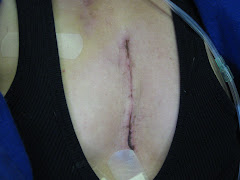- Pressures are now in an operable range. Since May, Pulmonary Vascular Resistant (PVR) pressures dropped from 10 to 8.3 PVR. The opererable range is between 6-8 PVR. Therefore, I am in the upper range of that threshold.
- Signs of shunting from right to left are now non-existant. An indicator that the Pulmonary Pressures have gone down. The Atrial Septal Defect (ASD), which is the hole in the upper chambers of my heart had been providing relief from these high pressures.
After the Right-Heart Catheterization, we meet with Dr.'s; Torres (Pulmonologist), Warner (Cardiologist) and Ring (Cardio Thoracic Surgeon) to get individual opinions on my progress. All are enthusiastic with my progress but collectively they agree that continuting my (medication and oxygen) therapy, for an additional 3-months, is beneficial in determining if PVR and Pulmonary pressures can continue to decrease or if they've plateu . There would be a short -term and long -term benefit from reducing the pressures. Not only would the surgery be less risky but the lower I can reduce my pressures prior to surgery may affect the degree of PH I will be left with from a longterm perspective. The Dr.'s reiterate, "there is no exact science " to conclude whether or not I will be left with PH, after surgery. As a result, I will continue the therapy, trust that pressures go down and maintain the confidence that a life WITHOUT Oxygen, Flolan and (even better) PH are around the corner.
So, in three-months (February 08), we will be headed back to UTSW for yet another Right-Heart Catheterization. With the support of my Dr.'s, I will go ahead and have surgery during that same visit, if pressures continue to decrease. Yeah!!! The Visit is schedule for the week of February 16th, 2009. It'll be a HAPPY NEW YEAR!
Activity: I have been riding my bike 1-2 miles, once or twice a week. I have also been back to yoga, also once or twice a week.
Medications: No change to medications (Flolan, Tracleer, Lasix, Warfarin/Coumadine and Oxygen)





















